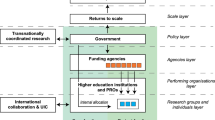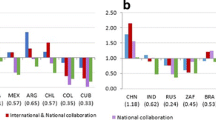Abstract
An extensive body of research indicated that the USA and China were the first two largest producers in the nanoscience and nanotechnology field while China performed better than USA in terms of quantity; it had produced inferior quality publications. Yet, no studies investigated whether the specific institutions are consistent with these conclusions or not. In this study, we identify two institutions National Center for Nanoscience and Technology (NCNST) from China and University of California Los Angeles-California Nanosystems Institute (CNSI) from the USA) and compare their scientific research. Further, we develop and exploit a novel and updated dataset on paper co-authorship to assess their scientific research. Our analysis reveals NCNST has many advantages in regards to author and paper quantities, growth rate and the strength of collaborations but loses dominance with respect to research quality. We do find that the collaboration networks of both NCNST and CNSI have small-world and scale-free properties. Besides, the analysis of knowledge networks shows that they have similar research interests or hotspots. Using statistical models, we test and discover that degree centrality has a significant inverted-U shape effect on scientific output and influence. However, we fail to find any significant effect of structural holes.







Similar content being viewed by others
References
Abbasi, A., Altmann, J, & Hossain, L. (2011). Identifying the effects of co-authorship networks on the performance of scholars: A correlation and regression analysis of performance measures and social network analysis measures. Journal of Informetrics, 5(4), 594–607.
Abbasi, A., Hossain, L., & Leydesdorff, L. (2012). Betweenness centrality as a driver of preferential attachment in the evolution of research collaboration networks. Journal of Informetrics, 6, 403–412.
Adams, J. (2012). Collaborations: The rise of research networks. Nature, 490(7420), 335–336.
Adams, J. (2013). Collaborations: The fourth age of research. Nature, 497(7451), 557–560.
Ahuja, G. (2000). Collaboration networks, structural holes, and innovation: A longitudinal study. Administrative Science Quarterly, 45(3), 425–455.
Ajiferuke, I., Burell, O., & Tague, J. (1988). Collaborative coefficient: A single measure of the collaboration in research. Scientometrics, 14, 421–433.
Albert, R., Jeong, H., & Barabási, A. L. (2000). Attack and error tolerance of complex networks. Nature, 406, 378–382.
Bajwa, R. S., Yaldram, K., & Rafique, S. (2013). A scientometric assessment of research output in nanoscience and nanotechnology: Pakistan perspective. Scientometrics, 94(1), 333–342.
Balconi, M., Breschi, S., & Lissoni, F. (2004). Networks of inventors and the role of academia: An exploration of Italian patent data. Research Policy, 33(1), 127–145.
Barabási, A. L., & Albert, R. (1999). Emergence of scaling in random networks. Science, 286, 509–512.
Bornmann, L., & Leydesdorff, L. (2014). Topical connections between the institutions within an organisation (institutional co-authorships, direct citation links and co-citations). Scientometrics,. doi:10.1007/s11192-014-1425-1.
Burt, R. S. (1992). Structural holes: The social structure of competition. Cambridge, MA: Harvard University Press.
Burt, R. S. (2004). Structural holes and good ideas. American Journal of Sociology, 110(2), 349–399.
Cainelli, G., Maggioni, M. A., Uberti, T. E., & Felice, A. D. (2015). The strength of strong ties: How co-authorship affect productivity of academic economists? Scientometrics, 102(1), 673–699.
Carnabuci, G., & Bruggeman, J. (2009). Knowledge specialization, knowledge brokerage and the uneven growth of technology domains. Social Forces, 88(2), 607–642.
CAS. (2003). http://www.cas.cn/xw/kjsm/gjdt/200906/t20090608_623423.shtml. Accessed September 25, 2014
Chen, Z. F., & Guan, J. C. (2010). The impact of small world on innovation: an empirical study of 16 countries. Journal of Informetrics, 4, 97–106.
CNSI. (2014a). http://www1.cnsi.ucla.edu/index. Accessed September 25, 2014
CNSI. (2014b). http://www.cnsi.ucsb.edu/about/. Accessed September 25, 2014
CNSI. (2014c). http://www.cnsi.ucsb.edu/about/cnsi_brochure.pdf. Accessed September 25, 2014
CNSI. (2014d). http://www1.cnsi.ucla.edu/external-affairs/page2.html. Accessed September 25, 2014
Fleming, L. (2001). Recombinant uncertainty in technology search. Management Science, 47(1), 117–132.
Fleming, L., Mingo, S., & Chen, D. (2007). Brokerage and collaborative creativity. Administrative Science Quarterly, 52(3), 443–475.
Fu, T. Z. J., Song, Q. Q., & Chiu, D. M. (2014). The academic social network. Scientometrics, 101, 203–239.
Gonzalez-Brambila, C. N., Veloso, F. M., & Krackhardt, D. (2013). The impact of network embeddedness on research output. Research Policy, 42, 1555–1567.
Guan, J. C., & Gao, X. (2008). Comparison and evaluation of Chinese research performance in the field of bioinformatics. Scientometrics, 75(2), 357–379.
Guan, J. C., & Liu, N. (2014). Measuring scientific research in emerging nano-energy field. Journal of Nanoparticle Research, 16, 2356.
Guan, J. C., & Ma, N. (2007). China’s emerging presence in nanoscience and nanotechnology: A comparative bibliometric study of several nanoscience ‘giants’. Research Policy, 36(6), 880–886.
Guan, J. C., & Wang, G. B. (2010). A comparative study of research performance in nanotechnology for China’s inventor–authors and their non-inventing peers. Scientometrics, 84, 331–343.
Guan, J. C., Yan, Y., & Zhang, J. J. (2014). How do collaborative features affect scientific output? Evidences from wind power field. Scientometrics,. doi:10.1007/s11192-014-1311-x.
Heinze, T. (2004). Nanoscience and nanotechnology in Europe: Analysis of publications and patent applications including comparisons with the United States. Nanotechnology Law & Business, 1(4), 427–445.
James, A. E., & Jacob, G. F. (2011). Metaknowledge. Science, 331, 721–725.
Karpagam, R., Gopalakrishnan, S., Natarajan, M., & Ramesh Babu, B. (2011). Mapping of nanoscience and nanotechnology research in India: A scientometric analysis, 1990–2009. Scientometrics, 89, 501–522.
Kavyasrujana, D., & Rao, B. C. (2015). Hierarchical clustering for sentence extraction using cosine similarity measure. Advances in Intelligent Systems and Computing, 337, 185–191.
Kostoff, R. N. (2012). China/USA nanotechnology research output comparison—2011 update. Technological Forecasting and Social Change, 79, 986–990.
Kostoff, R. N., Barth, R. B., & Lau, C. G. Y. (2008). Quality vs quantity of publications in nanotechnology field from the Peoples Republic of China. Chinese Science Bulletin, 53(8), 1272–1280.
Kostoff, R. N., Koytcheff, R. G., & Lau, C. G. Y. (2007). Global nanotechnology research metrics. Scientometrics, 70(3), 565–601.
Lee, J. (2010). Heterogeneity, brokerage, and innovative performance: Endogenous formation of collaborative inventor networks. Organization Science, 21(4), 804.
Lee, D. H., Seo, I. W., Choe, H. C., & Kim, H. D. (2012). Collaboration network patterns and research performance: The case of Korean public research institutions. Scientometrics, 91(3), 925–942.
Leydesdorff, L., & Wagner, C. (2009). Is the United States losing ground in science? A global perspective on the world science system. Scientometrics, 78(1), 23–36.
Mahapatra, M. (1985). On the validity of the theory of exponential growth of scientific literature. In Proceedings of the 15th IASLIC conference, Bangalore (pp. 61–70). Bangalore.
McFadyen, M. A., & Cannella, A. A. (2004). Social capital and knowledge creation: Diminishing returns of the number and strength of exchange. Academy of Management, 47(5), 735–746.
NCNST. (2014a). http://www.nanoctr.cn/. Accessed September 25, 2014.
NCNST. (2014b). http://www.nanoctr.cn/xwdt/xshd/201001/t20100128_2737716.html. Accessed March 25, 2014.
Newman, M. E. J. (2001). The structure of scientific collaboration networks. Proceedings of the National Academy of Sciences, 98(2), 404–409.
Phelps, C., Heidl, R., & Wadhwa, A. (2012). Knowledge, networks, and knoweldge networks: A review and research agenda. Journal of Management, 38(4), 1115–1166.
Podolny, J. M., & Baron, J. N. (1997). Resources and relationships: Social networks and mobility in the workplace. American Sociological Review, 62(5), 673–693.
Rodan, S. (2010). Structural holes and managerial performance: Identifying the underlying mechanisms. Social Networks, 32(3), 168–179.
Rodan, S., & Galunic, C. (2004). More than network structure: How knowledge heterogeneity influences managerial performance and innovativeness. Strategic Management Journal, 25, 541–562.
Rotolo, D., & Messeni Petruzzelli, A. (2013). When does centrality matter? Scientific productivity and the moderating role of research specialization and cross-community ties. Journal of Organizational Behavior, 34, 648–670.
Sabidussi, Gert. (1966). The centrality index of a graph. Psychometrika, 31(4), 581–603.
Savanur, K., & Srikanth, R. (2010). Modified collaborative coefficient: A new measure for quantifying the degree of research collaboration. Scientometrics, 84(2), 365–371.
Shipilov, A. V. (2009). Firm scope experience, historic multimarket contact with partners, centrality, and the relationship between structural holes and performance. Organization Science, 20, 85–106.
Tang, L., & Shapira, P. (2011). China–US scientific collaboration in nanotechnology: patterns and dynamics. Scientometrics, 88(1), 1–16.
UCOP (University of California Office of the President). (2014). http://www.ucop.edu/california-institutes/about/about.htm. Accessed September 25, 2014
Uzzi, B., & Spiro, J. (2005). Collaboration and creativity: The small world problem. American Journal of Sociology, 111(2), 447–504.
Wang, G. B., & Guan, J. C. (2010). The role of patenting activity for scientific research: A study of academic inventors from China’s nanotechnology. Journal of Informetrics, 4(3), 338–350.
Wang, G. B., & Guan, J. C. (2011). Measuring science-technology interactions using patent citations and author–inventor links: An exploration analysis from Chinese nanotechnology. Journal of Nanoparticle Research, 13(12), 6245–6262.
Wang, C. L., Rodan, S., Fruin, M., & Xu, X. Y. (2014). Knowledge networks, collaboration networks, and exploratory innovation. Academy of Management Journal, 57(2), 484–514.
Wang, X. W., Xu, S. M., Liu, D., & Liang, Y. X. (2012). The role of Chinese-American scientists in China–US scientific collaboration: A study in nanotechnology. Scientometrics, 91(3), 737–749.
Wang, X. W., Xu, S. M., Wang, Z., Peng, L., & Wang, C. L. (2013). International scientific collaboration of China: collaborating countries, institutions and individuals. Scientometrics, 95, 885–894.
Watts, D. J. (1999). Small worlds: The dynamics of networks between order and randomness. Princeton: Princeton University Press.
Watts, D. J., & Strogatz, S. H. (1998). Collective dynamics of small-world. Nature, 393(6684), 440–442.
Yayavaram, S., & Ahuja, G. (2008). Decomposability in knowledge structures and its impact on the usefulness of inventions and knowledge-base malleability. Administrative Science Quarterly, 53, 333–362.
Zhao, Y. L. (2013). Nanosciences at NCNST: From fundamental research to industrial applications. Small (Weinheim an der Bergstrasse, Germany), 14, 2381.
Zhou, P., & Bornmann, L. (2014). An overview of academic publishing and collaboration between China and Germany. Scientometrics,. doi:10.1007/s11192-014-1418-0.
Zhou, P., & Leydesdorff, L. (2006). The emergence of China as a leading nation in science. Research Policy, 35(1), 83–104.
Acknowledgments
This research is funded by National Natural Science Foundation of China (Project No. 71373254). The authors are very grateful for the valuable comments and suggestions of the anonymous reviewers and Editor in Chief Wolfgang Glänzel, which significantly improved the article.
Author information
Authors and Affiliations
Corresponding author
Additional information
Jiancheng Guan and He Wei are alphabetically ordered and they contributed equally to this paper.
Rights and permissions
About this article
Cite this article
Guan, J., Wei, H. A bilateral comparison of research performance at an institutional level. Scientometrics 104, 147–173 (2015). https://doi.org/10.1007/s11192-015-1599-1
Received:
Published:
Issue Date:
DOI: https://doi.org/10.1007/s11192-015-1599-1




